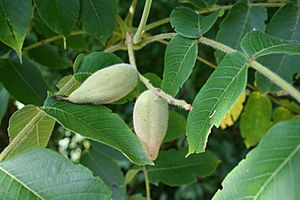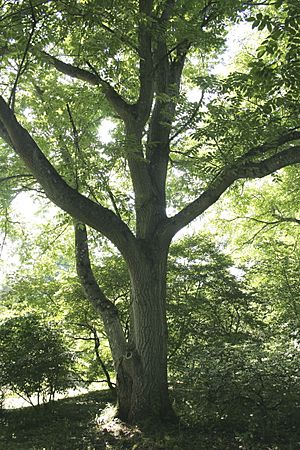Manchurian walnut facts for kids
Quick facts for kids Manchurian walnut |
|
|---|---|
 |
|
| Manchurian walnut | |
| Scientific classification | |
| Genus: |
Juglans
|
| Species: |
mandshurica
|
The Manchurian walnut (scientific name: Juglans mandshurica) is a type of tree that loses its leaves every year. It's also called Tigernut. This tree belongs to the walnut family, Juglans.
You can find the Manchurian walnut growing naturally in East Asia. This includes countries like China, the Russian Far East, North Korea, and South Korea. These trees can grow quite tall, reaching about 25 meters (which is about 82 feet).
Contents
Discovering the Manchurian Walnut
A Russian scientist named Carl Johann Maximowicz was the first to officially describe this tree. He wrote about it in a science publication in 1856. This was an important step in understanding and naming plants around the world.
What the Manchurian Walnut Looks Like
Leaves and Flowers
The leaves of the Manchurian walnut are quite large. They can be between 40 to 90 centimeters (about 16 to 35 inches) long. Each leaf has many smaller leaflets, usually from 7 to 19 of them. These leaflets are shaped like a spear and have tiny saw-like edges.
Male flowers on the tree hang down in long clusters called catkins. These can be 9 to 40 centimeters (about 3.5 to 16 inches) long. Female flowers grow in smaller groups at the ends of branches.
How the Tree Reproduces
The Manchurian walnut flowers in April or May. Its flowers are pollinated by the wind, meaning the wind carries pollen from male to female flowers. After pollination, the female flowers develop into nuts.
These nuts ripen between August and October. They are usually 3 to 7.5 centimeters (about 1 to 3 inches) long. The nuts have a thick, green outer husk that feels a bit sticky and hairy. Inside, there's a very hard shell protecting the edible kernel.
Where Manchurian Walnuts Grow
This tree is incredibly tough and can survive very cold weather, even down to -45 degrees Celsius (-49 degrees Fahrenheit). It also grows quickly. Because it's so hardy, people often plant it as an ornamental tree in colder parts of the Northern Hemisphere. For example, it grows well in places like Edmonton, Canada.
The nuts of the Manchurian walnut can be eaten. However, the kernels inside are small and quite hard to get out of their thick shells. The wood from this tree is also used, but it's not as valuable as the wood from other walnut trees, like the English walnut or black walnut.
Special Plant Interactions
The Manchurian walnut produces certain natural chemicals. These chemicals can affect other plants growing nearby. This effect is called allelopathy. However, the Manchurian walnut produces much less of these chemicals than other types of walnuts. This means it usually doesn't cause many problems for other plants growing around it.
Related Walnut Species
There are other walnut trees that are closely related to the Manchurian walnut.
- The Juglans cathayensis is a similar tree. It has hairy leaflets and produces more flowers. It grows south of the Yellow River in China. Some experts used to think it was a completely separate species.
- The Japanese walnut (also known as オニグルミ) is another close relative. Some scientists consider it a variety of the Manchurian walnut, sometimes called Juglans mandshurica var. sachalinensis.
See also
In Spanish: Juglans mandshurica para niños


